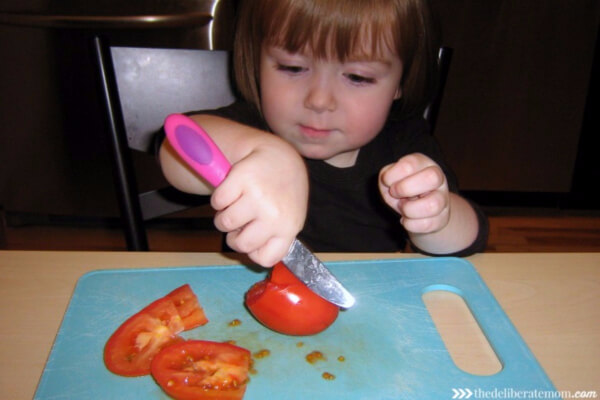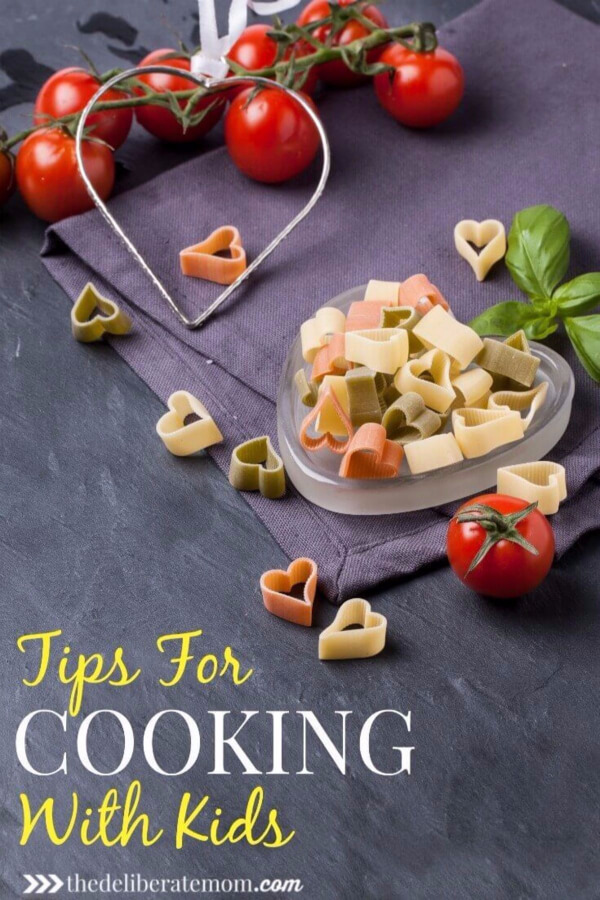I love to cook with my daughter. Some of my blog demonstrates my joy of cooking with her. She loves it, and it’s a real experience for her… not a chore or task but something meaningful.
The more I cook with my daughter, the more I realize how much she’s learned from these experiences. She’s learned new words, numbers, counting, colours, and even some science.
As an early childhood educator, I can attest to the many and varied benefits of cooking with kids. However, there is a big difference between cooking with one or two children as opposed to when I’m at work, and I’m cooking with four or five.
I thought I would share some of my tips and experiences with those of you who wish to cook with your children.
Check out these fabulous tips for cooking with kids! #cooking #kids Click To TweetTIPS FOR COOKING WITH KIDS
Be prepared.
Select your recipe and make sure you have all the ingredients before you start cooking with kids. There’s nothing worse than stopping the process because you don’t have any baking soda!!! If you have young children, gather all the ingredients ahead of time. If you have older children, they might enjoy the “game” of finding the ingredients you say that they will need. It’s also a good idea to gather your cleaning supplies ahead of time.
Talk (lots).
This is a time to speak and role model those great words that your children may otherwise not be exposed to… wonderful words like whisk, knead, sieve, strain, simmer, etc. Don’t hold back! This is a wonderful opportunity to expand their vocabulary.
Have good quality equipment that your children can use.
Since I love colour, all of our baking equipment is colourful. We have coloured bowls, measuring spoons and mixing spoons. My daughter learned much of her colours through the process of baking (i.e. “Pour the flour into the purple bowl”.) I am also okay with her using the equipment. It’s not fun for a child if they can’t touch or use anything.
Also, as well-meaning parents, we often fret about our children using knives. Under close supervision you can teach your child this important skill. An older preschooler has enough steadiness to be able to handle a knife. Show them how to position their hands and let them use a real knife. “Practicing” with a plastic knife could do more damage (as the weight of a plastic knife is entirely different from a “real” cutting knife).
Involve them in “reading” the recipe.
If they are very young, read the recipe to them. Point to each line as you read it. Older children who know how to read can read the recipe out loud for all to hear. Some great cookbooks for children include:
Pretend Soup and Other Real Recipes: A Cookbook for Preschoolers and Up
Salad People and Other Real Recipes: A New Cookbook for Preschoolers and Up
These cookbooks have great pictorial instructions which make them fantastic cookbooks for preschoolers to use. Another cookbook to investigate is:
Honest Pretzels: And 64 Other Amazing Recipes for Cooks Ages 8 & Up
Expect a mess (and be okay with it).
Cooking with kids is bound to be messy. As mentioned previously, part of being prepared is having your cleaning supplies handy (i.e. paper towels, washcloths, a small broom and dust pan, mop). The experience should far outweigh the necessity for cleanliness… your children will love the experience as long as you don’t fret over every bit of flour that gets on the kitchen floor.

Be a positive role model.
Demonstrate good hygiene by washing your hands frequently (and encouraging them to do so). Don’t sample the food while making it. Model safe cooking behaviours (i.e. cutting safely, pointing pot handles to the back of the stove, etc.)
Allow lots of time for the experience.
Do not cook with children if you have an impending deadline. Enjoy, don’t rush the process.
Ask lots of questions.
Get them to critically think about the process. Ask questions that allow them to think about what is happening. (i.e. What does the flour look like? Describe what you smell. What do you think will happen when we add the baking soda? How does the dough feel in your hands?)
Get them to do most of the work.
Measuring, mixing, pouring… most of these things can be done by a child who’s over two. Sometimes they may need some hand-over-hand guidance but the benefit of actually doing these things is so great!
Involve them in the process of cleaning up.
Encourage them to load the dishwasher and put away the ingredients.
Celebrate.
Celebrate with the eating of the food that has been made! Make recipes which allow food to be consumed within a reasonable period. Children want the gratification of tasting their efforts. The less time they have to wait, the better!
Incorporate cooking into their play.
Provide a bin of real-life cooking equipment for them to play with on a day-to-day basis. Bowls, pots and pans, spoons, measuring cups and cutting boards make for good play equipment. This allows your children to make sense of the process by reenacting it in their play.
I hope these tips and suggestions inspire you to venture into the kitchen with your children. It is such a valuable experience that everyone is sure to benefit from. Do you cook with your children? Any additional suggestions or ideas are welcome!
Bon Appétit!!!










So inspiring.(again. Jennifer, really, your blog is awesome).
Can’t wait til my kitchen renos are done and Eva and I can get baking!! I may just look around for one of those cookbooks for her for Christmas. She’ll love it!! Thanks again :)
These are our favourite kids cook books too.
Great post! My daughters are 12 now, and we still love to cook together! These days it’s not quite as messy as it used to be when they were little ones, but still just as much fun :)
I love these tips! My kids love to cook in the kitchen with me…I haven’t let them use a knife yet, but I think I will give it a try.
I’m delighted you enjoyed these tips Miranda. Cooking with children can be so much fun!
My 2 yr old granddaughter doesn’t like the hand on hand method. We end up with a much bigger mess then when we each have our own spoon in the bowl.
Yes, sometimes hand-over-hand works better with some children than with others.
I love this post. I’m not sure how I missed it before! I cook with my kids all the time! I especially enjoy your comment about using knives! My kids have been using real (somewhat dull) knives since they grew out of the throwing stuff stage (carefully supervised of course!) I’m sure my Mother-in-Law would have a heart attack, but I think some of the greatest lessons involve risk. They could get a small cut, but having the responsibility to use real tools is such a great skill and builds confidence. We are starting to explore egg cracking too. I’ve become quite skilled at fishing out shells, but my 5 year old is getting pretty good now! ;)
I could have guessed you would love cooking with your children Shilo :)
Often people are so scared of introducing knives to their children but it’s an important skill to master and also can help protect them from injuries because they learn how important it is to use it properly.
We’ve done some egg cracking here but we really should do more of it.
Thanks for sharing your thoughts on cooking with children Shilo. I’m delighted you enjoyed these tips.